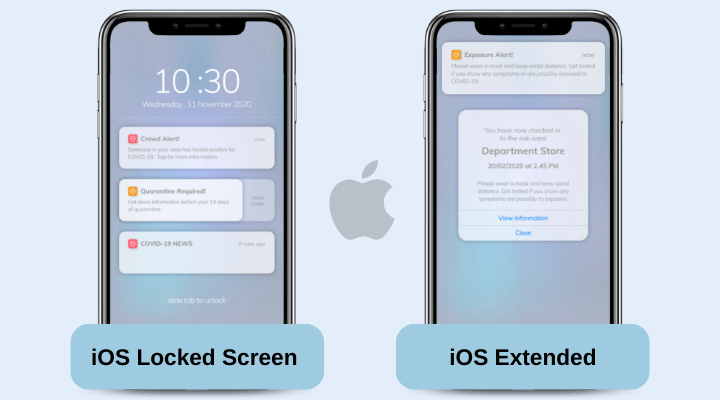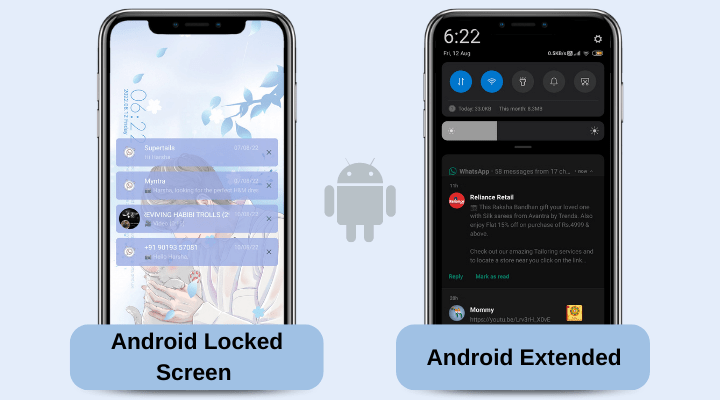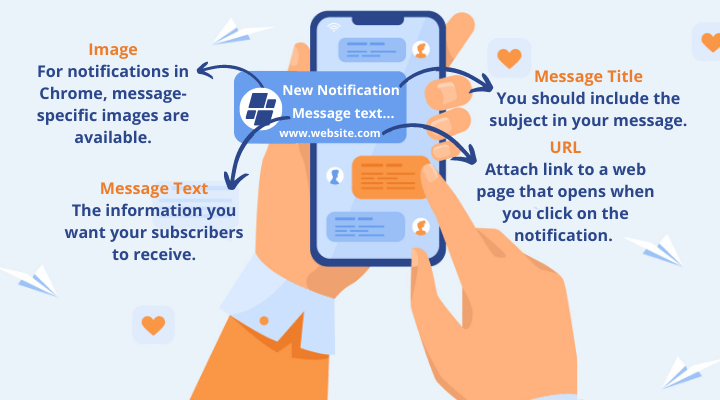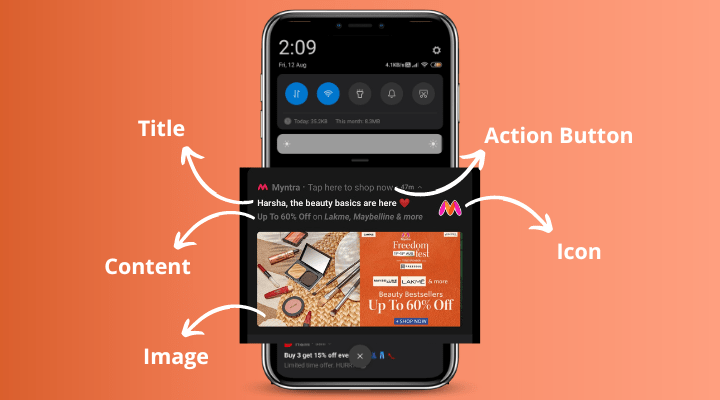Struggling with your push notifications? Discover 10 common push notifications mistakes and how to steer clear of them for a better experience.
Have you ever been rudely awakened by the relentless beeping of your phone, only to find it’s just another promotional message or an app notification? These nuisances can lead to app uninstalls and subscription cancellations. Picture this: you’re enjoying an afternoon coffee break, checking your phone for missed calls, texts, or emails when a push notification pops up. It’s about a sale on those boots you’ve been eyeing, complete with pictures and a special promo code. You immediately open the app, find your favorite pair, and make the purchase. That’s the power of a well-timed push notification.
However, push notifications can either engage or annoy users. To ensure they’re effective, you need to steer clear of these ten common push notifications mistakes. But, first, let’s understand a bit about push notifications and their importance.
WHAT ARE PUSH NOTIFICATIONS?
Push notifications are the short CTA (Call-to-action) message that pops up on your phone, even when you’re not using that app. Apps generally send push notifications to get your attention and share important information, reminders, or exciting offers with you.
These notifications usually have a title, a message, a picture, and a web link. Sometimes, they can also have logos, images, or emojis to make them look more attractive and fun. Depending on whether you use an Android device or an Apple phone, push notifications might look a bit different.


So, the next time you see a such message pop up on your device’s screen, it’s probably a push notification trying to tell you something interesting!
WHY ARE PUSH NOTIFICATIONS IMPORTANT?
Push notifications are like secret messengers for your mobile apps. They pop up on your device to grab your attention, even if you’re not using the app. Here are five cool reasons why they matter:
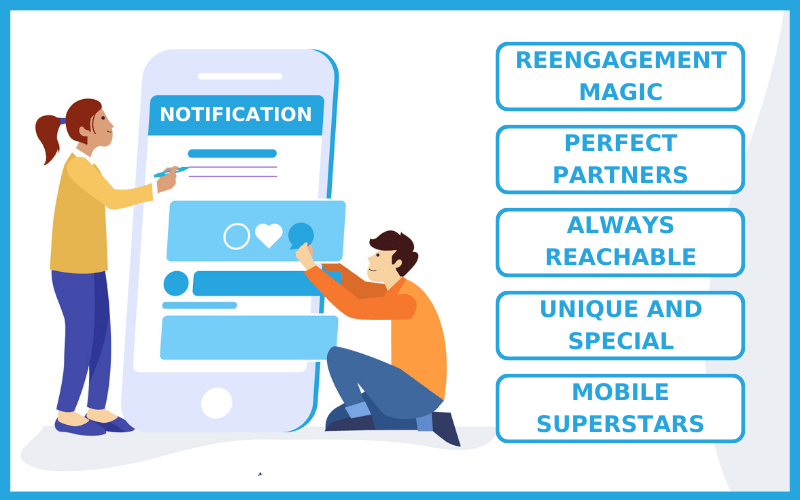
Always Reachable: Push notifications can talk to app users anytime, anywhere, whether they’re using the app or not. That’s like having a direct line to your users’ attention.
Reengagement Magic: If people forget about your app, push notifications can remind them it exists and bring them back. It’s like a friendly nudge, saying, “Hey, we’re here!”
Perfect Partners: They work great alongside emails, text messages, and web notifications. It’s like having a superhero team of communication.
Mobile Superstars: When we say, “push notifications,” we often mean the ones on mobile devices. They’re super popular and have superpowers to capture attention.
Unique and Special: Push notifications have a unique charm. They always stand out in a crowd of boring SMSs and other alerts, making sure you don’t miss the important stuff.
So, remember, push notifications are your app’s little helpers, ensuring your messages reach the right people at the right time.
For more information read: Push Notification Explained And Why Do They Matter?
Also read: Push Vs SMS: Which Is Better?
TOP 10 MISTAKES TO AVOID WHILE SENDING PUSH NOTIFICATIONS
Following are the top 10 common mistakes that you must avoid while sending mobile app push notifications.
1. USING PUSH NOTIFICATION AS EMAIL REPLACEMENT:
Push notifications are like digital post-it notes for your users. They can be used for different purposes, just like emails. You can send out announcements, order updates, and special offers through channels like SMS, in-app messages, and emails.
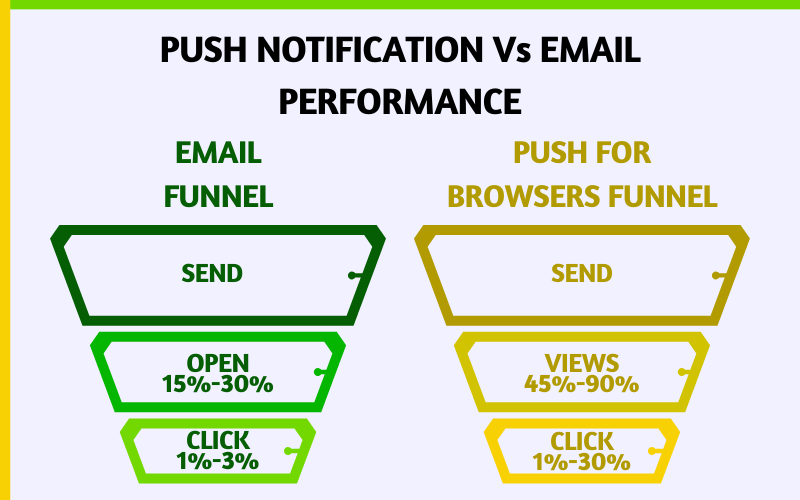
Sending push notifications, the correct way:
Push notifications work best when they’re like a friendly tap on the shoulder, sharing info that’s super relevant right now. Think about things like nearby deals, price drops, or limited-time offers. Save those push notifications for moments when your users will really appreciate them.
Bad Push Notification:
“Get 10% off at our store today! Hurry, the offer ends soon!”
Better Push Notification:
“Hey there!  Looking for deals nearby? Check out our store for a surprise 10% discount today, just for you! But don’t rush, you’ve got all day to enjoy it.
Looking for deals nearby? Check out our store for a surprise 10% discount today, just for you! But don’t rush, you’ve got all day to enjoy it.  ”
”
2. NOT TARGETING THE PUSH NOTIFICATIONS:
When a user downloads your app, it clearly indicates their interest in your brand. It’s your golden opportunity to understand their preferences better. Start by collecting data on how they interact within the app and use this valuable information to craft user engagements that lead to higher conversions.
Sending push notifications, the correct way:
Instead of sending generic messages at your convenience, consider messages triggered by user actions or inactions. Align your marketing communication with the user’s journey toward making a purchase. Some key moments in the user’s app journey that have proven to boost engagement in e-commerce apps include:
First App Opening: Provide a warm welcome and guide users to relevant products and categories. Suggest items based on what’s frequently bought or similar to their preferences.
New User: Make new users feel special and engaged.
Cart Abandonment: Send a friendly reminder about the items left in their cart, encouraging them to complete their purchase.
Price Drop Alerts: Notify users about price drops on products they’ve recently viewed, added to their cart, or wish list.
Re-Engagement: For users who’ve been inactive for a while, offer look-alike recommendations to spark their interest again.
Time-Sensitive Discounts: Present time-bound discounts on categories or products aligned with the user’s interests.
By timing your messages effectively and tailoring them to user behavior, you can significantly enhance engagement and conversions in your e-commerce app.
Poorly Timed Push Notification (Bad Way):
“Check out our amazing deals on electronics now!”
Well-Timed Push Notification (Right Way):
User behavior: A user has recently viewed smartphones in the app and added one to their cart but abandoned it.
Push Notification (Right Way):
“ Price Drop Alert!
Price Drop Alert!  The smartphone you liked now comes with a special discount! Grab it before the deal expires!
The smartphone you liked now comes with a special discount! Grab it before the deal expires!  ”
”
3. SENDING TOO MANY PUSH NOTIFICATIONS:
One of the key considerations is ensuring that users don’t disable your push notifications. To achieve this, delve into user engagement data and prioritize delivering a positive user experience.
Sending push notifications, the correct way:
To ensure your push notifications hit the mark, it’s essential to follow a thoughtful approach. Linzi Breckenridge, Senior Content Marketing Manager at Vertical Response, suggests that every marketer should ask themselves seven fundamental questions before sending out push notifications:
Relevance: Is the content of the push notification genuinely relevant to the recipient’s interests or previous interactions with your app? Personalization can significantly improve engagement.
Timing: Have you considered the timing of your push notification? Sending messages at inappropriate hours may annoy users. Analyze their behavior to find the best timing.
Frequency: Are you bombarding users with too many notifications? Strike a balance between staying connected and overwhelming your audience.
Value: What value does the push notification offer to the user? It should provide something beneficial, whether it’s information, a discount, or a solution to a problem.
Clarity: Is your message concise and clear? Users should instantly understand what the notification is about and why it matters.
Call to Action (CTA): Does your push notification include a compelling CTA? Encourage users to take a specific action, like visiting your app, making a purchase, or exploring a new feature.
Feedback Loop: Are you actively seeking feedback from users about the notifications they receive? Their input can guide you in refining your push notification strategy over time.
4. SENDING PUSH NOTIFICATIONS ON INAPPROPRIATE TIMING:
Timing is key! Catch users when they’re most likely to respond for better results. Annoying them with untimely messages in the early morning or late at night can lead to app uninstalls due to irritation.
Sending push notifications, the correct way:
Take into account the user’s local time and their daily schedule. Dig deeper by analyzing user engagement patterns to pinpoint the times when they are most active. Tailor your messages to seamlessly align with their daily routines. Here’s how you can use rich media push notifications to connect with app users at various moments throughout the day.
Example:
Bad Timing Push Notification:
“Check out our new products now!” Sent on 6 am Sunday Morning!
Why It’s Bad:
This notification lacks consideration for the user’s schedule and may interrupt them at an inconvenient time, reducing the chances of engagement.
Improved Timing Push Notification:
“Good morning, [User’s Name]! Start your day with our latest arrivals. Tap to see what’s new!”
5. STATIC NOTIFICATIONS:
Push notifications have come a long way! They used to be boring, but now they can be as cool as ads. Here’s how they’ve evolved from simple text to awesome rich media.
Sending push notifications, the correct way:
To do it right, use multi-product carousels. Show off products with images, names, prices, and clickable buttons that take users right to the product in your app. Make your notifications pop! 
 Make your push notifications exciting with these ingredients:
Make your push notifications exciting with these ingredients:
Product image 
Product name 
Price details – like discounts or final prices 
Buttons that link to the product in your app 
And guess what? Rich media push works on both Android and iOS. It’s a clever and budget-friendly way to bring users back to your app! 

6. POOR MESSAGES AND CTAs (Call to Action) IN YOUR PUSH NOTIFICATION:
Choose the right words and actions that are proven to work. Keep your message short and clear because your users have limited time. Be straightforward and get to the point.
Sending push notifications, the correct way:
Many push notification tools let you see how your messages will appear to users. Use this feature to make sure your messages look exciting when your users see them.
Select CTAs that have been effective for you before. For example, does “BUY” or “SHOP” get more responses?
Should you mention the discount percentage or the final price in your message? It depends on what your users prefer. Different categories of users might respond better to one or the other. For example, electronics shoppers tend to click more when they see the final price, while luxury fashion buyers like to see the discount percentage. So, tailor your message accordingly for the best results.
Bad Push Notification:
“Check out our amazing deals now! Buy today!”
Right Way Push Notification:
“Hey [User’s name] Last chance! Get 50% off on selected jewellery brands  . Shop now!”
. Shop now!”
7. NOT PERSONALIZING PUSH NOTIFICATIONS:
When it comes to push notifications, it’s not just about sending messages; it’s about sending the right message at the right time. Think of it like tailoring a suit – one size doesn’t fit all. Personalization is key here. Studies show that personalizing notifications can boost conversions by up to 5.5%.
Sending push notifications, the correct way:
To nail personalization, you need a push notifications platform that dives deep into user preferences. Look for a tool that can personalize messages individually, not just to broad groups. It should connect with your app’s data, like what products users are interested in or if there are any ongoing discounts.
Here’s the secret sauce: Make sure this tool can analyze real-time user interactions and adjust your notifications accordingly. It’s like having a personal shopper who always knows what you want when you want it. 
Bad Push Notification:
“Check out our amazing deals! Click here!”
Right Way:
“Hey [User’s Name], we noticed you were eyeing those running shoes. Good news – they’re now 15% off! Grab your pair today and hit your fitness goals with style. 
 ”
”
This personalized message not only addresses the user by name but also offers a discount on a product they’ve shown interest in. It’s more likely to grab their attention and lead to action.
8. SENDING TOO MANY PUSHES, TOO OFTEN:
Receiving a barrage of push notifications can be quite irksome for users. While push messages are cost-effective, it’s important not to overdo it and annoy your audience.
Sending push notifications, the correct way:
To strike the right balance, create specific user groups and avoid including users in multiple segments. Establish frequency limits, cooldown periods, and prioritization algorithms to ensure you’re sending highly relevant notifications without bombarding users.
A good rule of thumb is to limit your weekly notifications to 3-5, and even then, make sure they offer something valuable. Understand how users incorporate your app into their daily routines and find opportunities to enhance their experience through push messages.
Another effective strategy is to segment users based on their app engagement level, setting lower frequency limits for highly engaged users to prevent uninstallation risks.
9. IGNORING THE PUSH NOTIFICATION DATA:
Don’t miss out on valuable data! Let your users register and enable push notifications. This information can be a game-changer when it comes to connecting with your audience effectively.
Sending push notifications, the correct way:
Many marketers make the mistake of using outdated email-focused strategies for mobile apps. By doing this, they miss out on the unique opportunities that mobile engagement offers. Pay attention to the push notifications that users respond to, as they can reveal their preferences and dislikes. This knowledge can guide you in reaching out to them at the right time and improving their journey to making a purchase.
10. SKIPPING THE TESTING PHASE
Experiment with various approaches to find what clicks with your audience. A/B testing can be your best friend when it comes to keeping app users interested.
Sending push notifications, the correct way:
To nail this, divide your users into two groups. One is based on who they are, and the other is based on how they use your app. Then, send them different messages tailored to their preferences. This helps you understand what each user likes.
Next, figure out the perfect time to connect with your mobile audience. Test two sets of campaigns. One should hit their screens at a local time when they’re usually active. The other set should pop up when they take specific actions in your app. This reveals the sweet spot when users are most eager to engage with your brand.
LAUNCH A PUSH NOTIFICATION-ENABLED APP WITH SWING2APP
Mobile app push notifications beat web and desktop notifications hands down. To turbocharge your goals and supercharge your push notification game, all you need is Swing2App. No coding skills, no extra costs, and no stress.
Guide to create & send push notifications using Swimg2App no-code app builder. Also, check out this YouTube video to understand the Swing2App push notifications better.
Swing2App is your ultimate tool for sending unlimited push notifications. Here’s why it’s a game-changer:
Segment and Target:
With Swing2App, you can precisely target different user groups, ensuring your messages are spot-on.
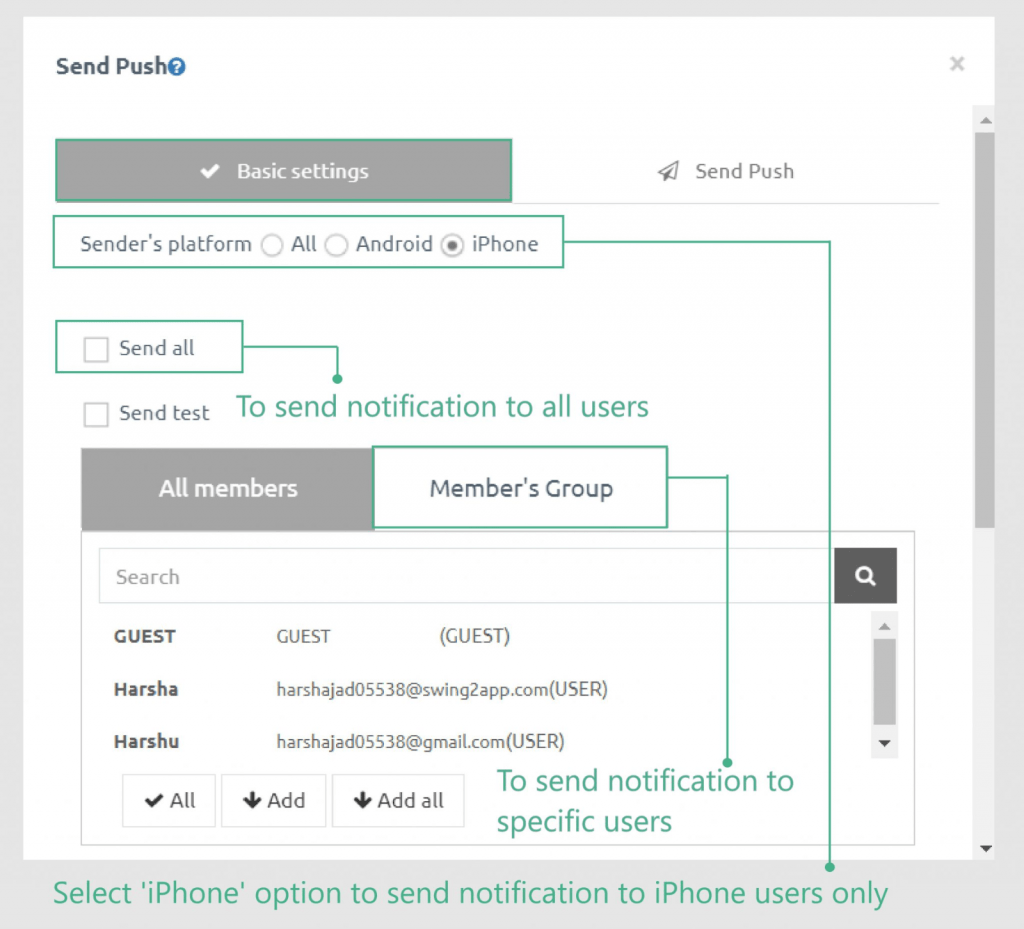
Personalized Notifications:
We make it simple to create personalized notifications that resonate with your audience.
Timing and Frequency Control:
Adjust when and how often your notifications go out with ease.
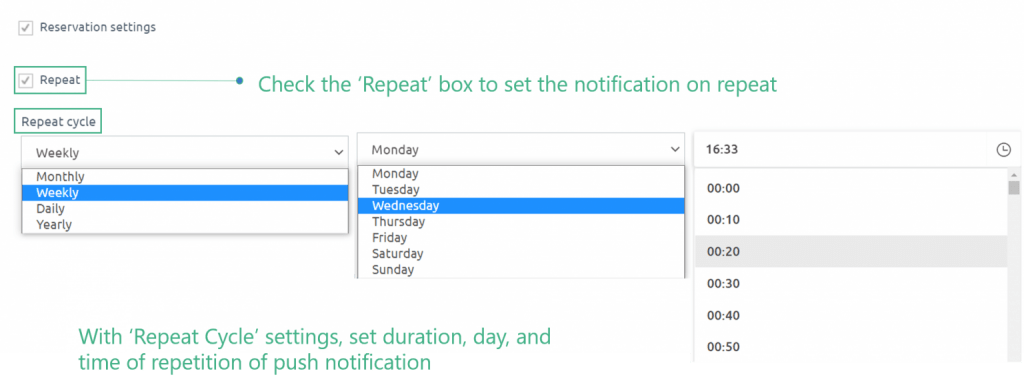
Add Images: Want to make your messages stand out? Swing2App lets you include images effortlessly.
effortlessly.
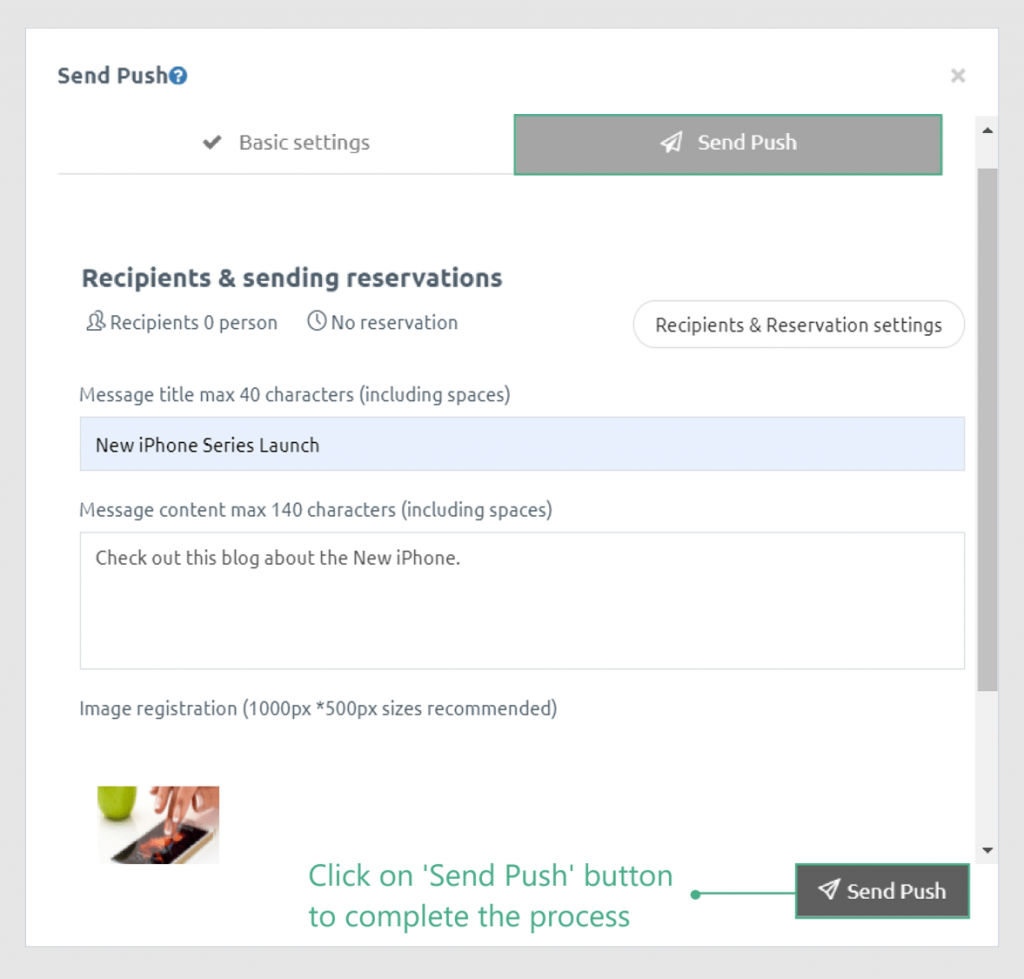
The finalized result will look something like this on the users’ screen:
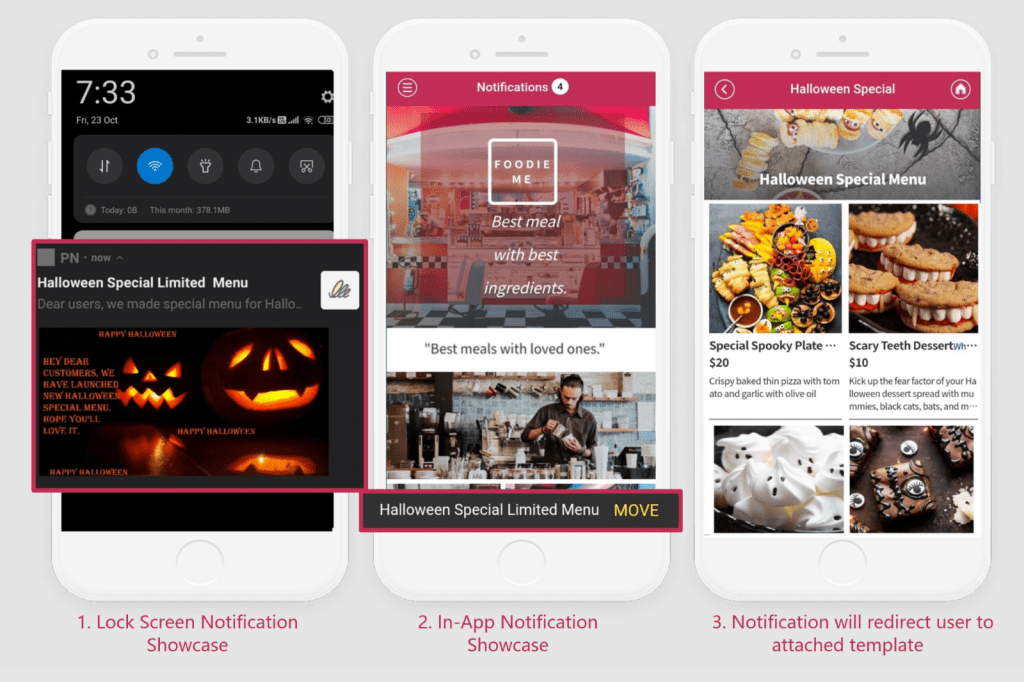
Swing2App’s no-code app builder empowers you to create your app in minutes. And guess what? It comes with awesome features like push notifications, chat, monetization, and more—all for free!
Managing push notifications is a breeze with Swing2App. You can set them up, schedule them, send them, and keep track of everything from one handy dashboard.
So, don’t wait. Build your app now, publish it on Google Play and the Apple App Store, and start wowing your users with push notifications. It’s time to launch killer campaigns and watch your profits soar!
Plus, here’s a bonus: You can also use Swing2App to send SMS messages, available as an optional extra. Say goodbye to limits and hello to effective communication with Swing2App!
Ready to build an App? Use Swing2App!
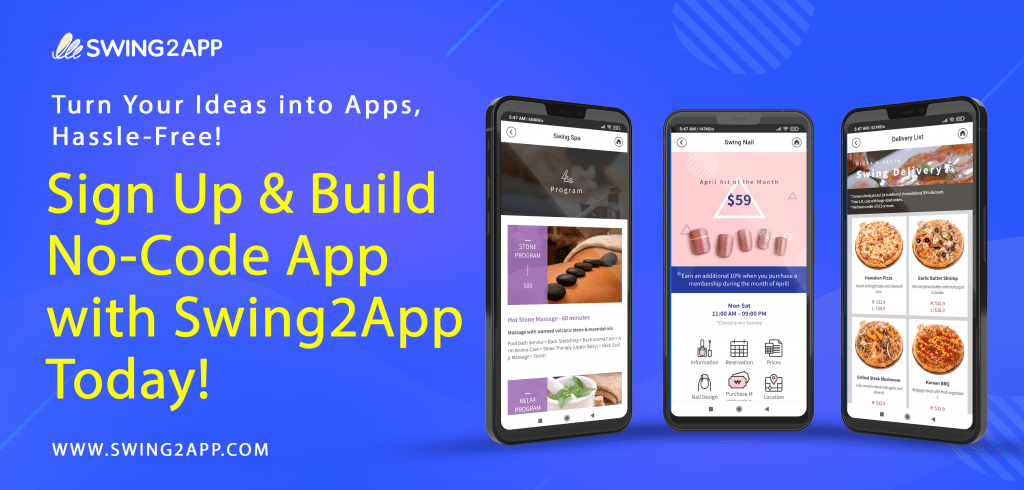
Push notifications are one of the trending marketing techniques with a mobile app. It is the best way to stay connected with your users even when they are not using your app.
In your app, you must have come across notifications like:
Hey, Kim the items you waitlisted are selling out fast! Order now your favourite dress!
These are called push notifications, which can be sent to the app user at any time whether the app is opened or not. It appears even on the lock screen, so your message is delivered even if the user does not use the mobile phone. This is highly beneficial, especially for time-sensitive messages (like expected delivery time, etc.)
You can use push notifications to drive engagement, increase app usage, connect with users, and so on. The possibilities are truly limitless.
However, you must follow the right way to use push notifications to get maximum benefits. To help you understand the right way I created this guide. Continue to read more about how push notifications work, why you should use them, when to use push notifications, and how to use them effectively.
What are Push Notifications?
A push notification is a small, pop-up message sent by a mobile app on a user’s device, even when the app isn’t open. These notifications are designed to grab the attention of users and convey reminders, updates, promotions, and more.
Push notifications usually consist of a title, a message, an image, and a URL. They may also include logos, emojis, and other elements to make them more attractive. Push notifications look different across various operating systems, such as Google Android and Apple OS.
Elements of a Push Notification
A push notification is a short message that is delivered directly to the home screen of a mobile device.
Push notifications are better than email and other customer communication methods because of the delivery method. Even though push alerts are like an SMS text message; pushes go directly to the smartphone user, and hence are more visible. This guarantees that users will see the push notification the next time they check their phone or tablet.
When users download an app, usually they opt-in to these push messages by default. But the user has more control over push notifications, it can be even disabled.
While there are certain similarities between push messages and texts, there are also some significant differences. When users open a push message, they get transported straight to the app and to a screen where they can read the rest of the message. This implies that the message must be short and engaging, ensuring the users can read everything in its entirety directly even from the lock screen.
This is one of the reasons why push messages with fewer words have a higher click rate:
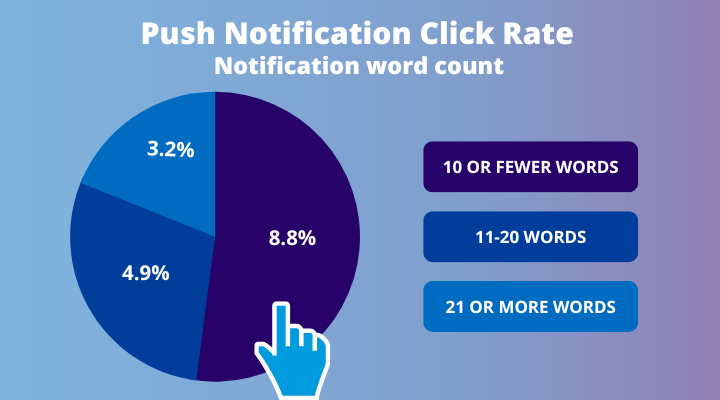
CTR: CTR is the number of clicks that your ad receives divided by impressions (the number of times your ad is shown): clicks ÷ impressions = CTR. For example, if you had 5 clicks and 100 impressions, then your CTR would be 5%.
Unlike emails and SMS texts, push alerts can be sent without the user sharing any contact information. However, the user must have the notifications enabled on their device, app publishers can send them at any time.
Android Vs iOS Push Notifications
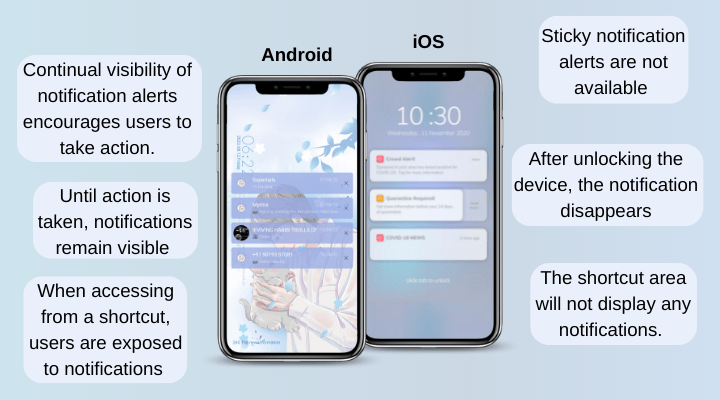
| iOS | Android | |
| Opt-In / Opt-out | Users must Opt-In to push notifications after installing the app | Automatically opted-in |
| Access push notification locked screen | They will see the notification on the lock screen, if they have enabled lock screen notifications for that application | They will see the notification on the lock screen unless they have disabled it. Most Android phones have a LED notification light which can be enabled. |
| How to view | Swipe down and see notification history in chronological order, with the option to delete each day. | In the notification tray by swiping down. Long-press an application’s icon and see just it’s recent notifications. |
| User notification options | Clear, open, long-press to see more info and application options like reply and snooze. | All those, plus snooze the notification for a predefined time period. |
| Change Notification Settings | Open the Settings App, go to Notifications, find the app. | Either in App Settings and then through the Apps and Notifications, or long-press an app’s icon, chose the info icon, and get to that app’s specific settings. |
| Notification display options | Disable/enable notifications, allow notifications on the lock screen, sounds, and show temporary or persistent banners. | Disable/enable notifications, allow notifications on the lock screen fully or hide sensitive information. When the phone is unlocked, notification dots on individual apps, enable the phone’s blink light, and allow sounds. |
Push Notification Functionality: How it Works
For a message to appear in a user’s notification center, there is a lot of work behind the scenes.
The first requirement is that a push notification service specific to each operating system is needed. Then push service must be enabled by the app publisher. As a result, the publisher has an API (application programming interface) to communicate with each service.
One example of an OS-specific service is Apple Push Notifications (APNs). Here’s how it works:
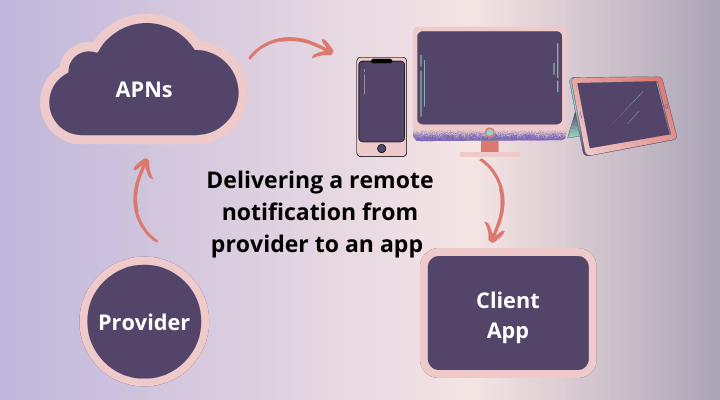
The process is slightly different if you’re using APNs to send messages from multiple providers to multiple devices (like smartphones, tablets, and computers).
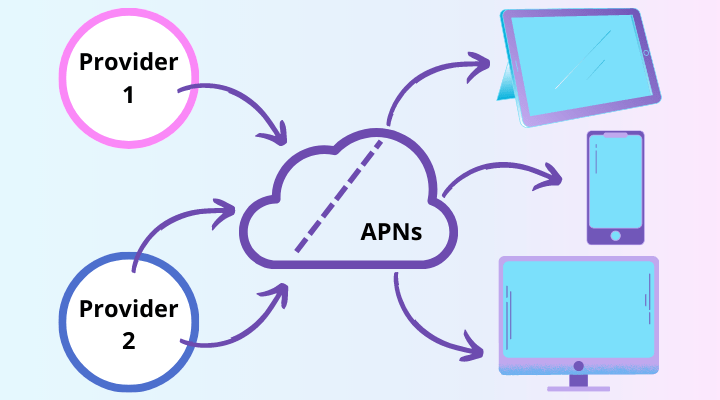
Beyond Apple Push Notifications, Google Firebase Cloud Messaging (FCM) and OneSignal are other examples of a notification service for Android devices.
The basic concepts behind how this works from the publisher’s end is quite straightforward. After you’ve been set up with a push notification sending platform, then you just have to draft a new message, select the target audience, and send the notification.
Why Use Push Notifications?
Push notifications are a powerful mobile-first communication channel that can reach app users anytime, whether or not they are in your app, to capture their attention and reengage them.
Using mobile push notifications, or push alerts sent to mobile devices, can complement your use of channels such as email, SMS, and web push notifications with a variety of unique benefits. Mobile push notifications are the most popular type of push notification and are often referred to simply as “push notifications” or “push.”
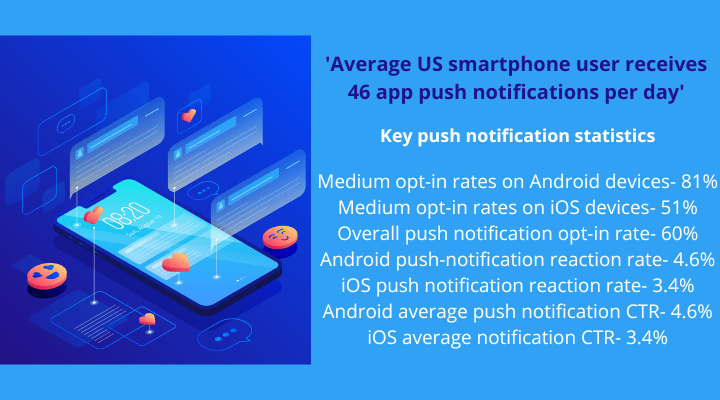
Push vs SMS
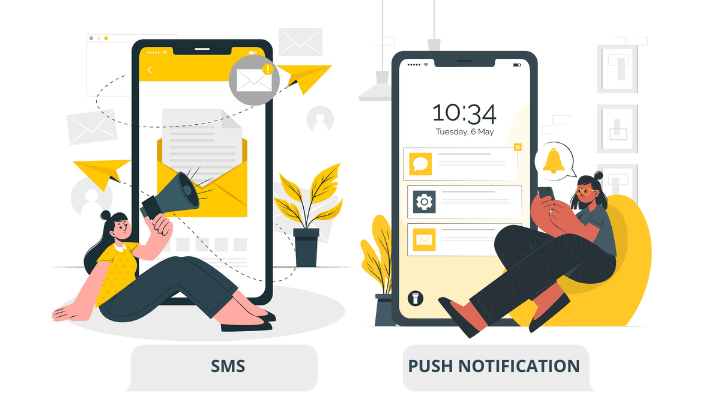
With SMS (or short messaging services) you can send text messages of up to 160 characters in length. On the other hand, Push notifications are brief to-the-point alerts triggered by an app that a customer has already downloaded. The app doesn’t have to be open for the push alert to appear.
There is no competition between the two. There are pros and cons to both methods. For instance, SMS gives you more flexibility, you can add links, and character limits are longer. Delivery is secured, and reliable, and customers are guaranteed to see your message (the 98% open rate). It’s easier to miss or skip a push notification that might only be visible for a limited time (cannot be re-read).
However, push notifications are easier to manage than SMS. You can send push notifications without recipients providing you with written consent. Moreover, it is less likely that users will take time to go into their notification settings to change the frequency and type of notifications.
With SMS, recipients must provide clear written consent and opt-in before your business can send them SMS messages. This is a huge barrier to entry.
Open rates for push notifications vary between 30% and 60%, and the interaction is as high as 40% according to a study by IBM partner Xtify. Look at the following image for comparison with email.
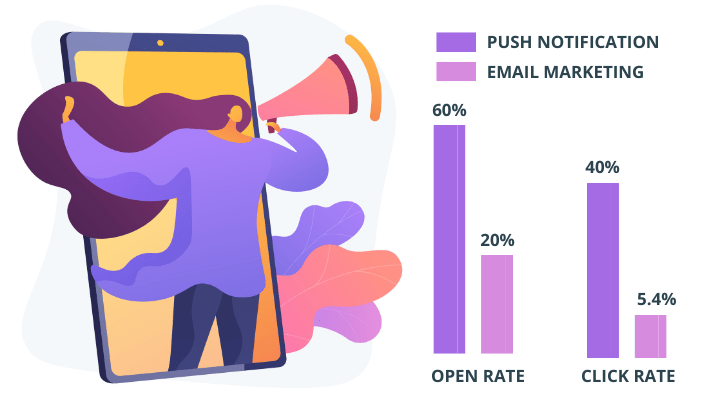
To summarise the differences between push and SMS:
| PUSH NOTIFICATIONS | SMS | |
| Opt-in ways | App installation in needed | Provide phone number verified by OTP |
| Opt-out ways | Turn off the notifications in settings | Send code to company to stop receiving SMSs |
| Visibility | One-time only and for a limited time | Can be viewed repeatedly in inbox as well as saved |
| Content | 1-2 sentences (very short) | 160 characters |
| Reach | Limited-only to those who have downloaded the app | Unlimited |
| Features | Links and rich media can be added: GIFs, emojis, photos, videos, audios, Custom CTAs | Only links can be added to the SMSs |
Things Push Notifications Can Help You Achieve
1. Increase Message Visibility
It ensures that your messages are at once seen, even when users are inactive. You can send time-sensitive messages and create a seamless user experience.
2. Drive Retention and Increase User Engagement
Highly visible push alerts remind your users to come back to your app. This boosts your website and app retention by re-engaging users with push. Engage your users with updates and new content.
3. Boost Conversions
Increase sales by designing and sending push notification campaigns related to in-app rewards, promos, discounts, or other deals.
4. Create a Connected User Experience (UX)
Reduce friction within the customer journey by sending transactional notifications to keep users informed and updated by creating a seamless experience.
Cons of Push notification marketing
1. Act like pop-up Ads
Generally, people do not like pop-up ads as they are disturbing. The push notifications pop out as Ads, which causes hindrance to regular activity. The notifications may come as surprise to the user which they do not like especially during work.
2. Work only when loyalty is already there
New users need to opt-in manually to the notifications when they download the app. New users who have just experienced your brand will hardly opt in to the notification for the first time.
3. Spamming:
Just like any other communication channel, marketers can misuse push notifications for spamming. They can use the real-time nature of mobile and web push alerts for bombarding a series of irrelevant messages.
4. You need additional setup: You cannot use push marketing without a push notification service or tool. However, push notification services are generally expensive. A full-fledged service will cost you around $150/1000 notifications.
Best Practices for Push Notifications
In order to maximize your results and meet users’ expectations, it’s essential to follow push notification best practices.
Ensure that your push notification adheres to these three points:
1. Relevant and timely: The user’s behaviour, location, or preference prompts the notification.
2. Personalised: The content of the push appeals to the individual user.
3. Actionable: The notification must make it clear what should the user do next.
Check out our blog to learn more about earning user permission, automation and scheduling messages, and other best practices for personalizing and optimizing push campaigns.
1. Deliver an exciting update – e.g. Spotify
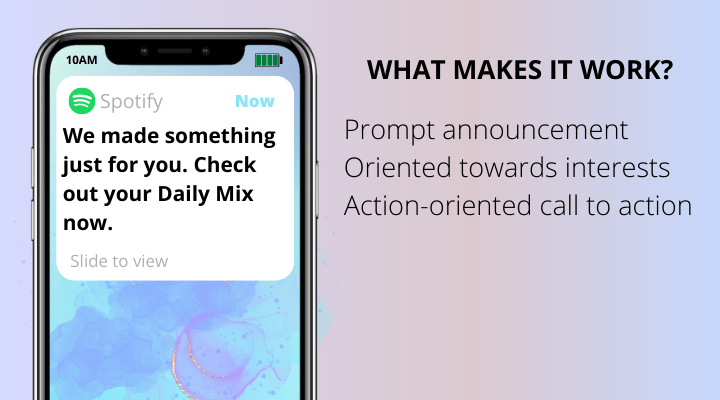
- Timely: Spotify sends this push notification to users when it added the Beatles’ discography to its library, so the interested users can listen it as soon as they get the notification.
- Personalized: It’s probable that the users who listen to music like “classic rock” or “oldies,” will receive this notification; which makes this push personalized to their taste.
- Actionable: The phrase “Play music’s greatest catalogue right now” tells the user what to do next and promises that users will enjoy it.
2. challenge the user or make an assumption – e.g. Tinder
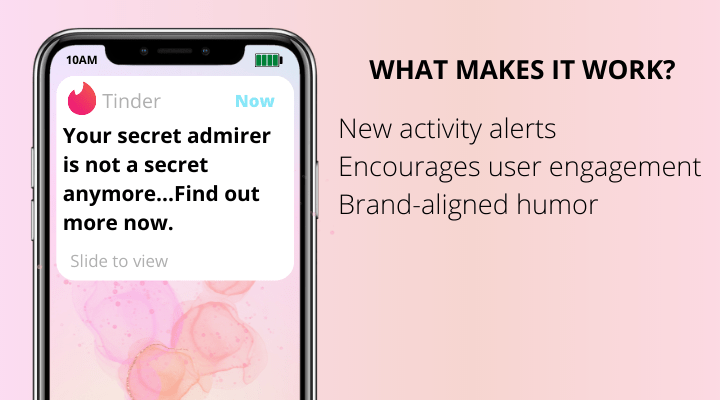
- Timely: This message is sent to Tinder dating app users when someone swipes right to imply interest.
- Personalized: It issues a challenge or make an assumption, which attracts the user. This may appear rude but given Tinder’s niche and brand identity, they can get away with it.
- Actionable: By saying in the push that it’s “probably not gonna work out,” Tinder has thrown a challenge to the user. It’s likely that the user is curious about the vague “new person” and swipes the app regardless of whether the connection works out or not.
3. Evoke self-reflection – e.g. Headspace
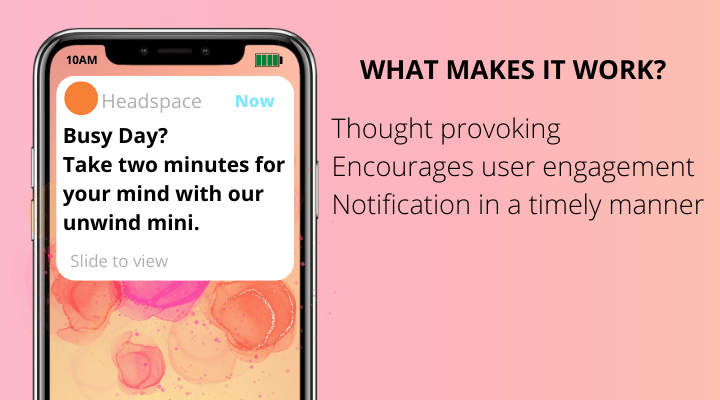
- Timely: The frequency and timing of these “Mindful Moment” push notifications are user-tracked inside the app.
- Personalized: Users are addressed as “you” in the push and asked compelling questions. Among social media updates and calendar events, these thought-provoking notifications stand out.
- Actionable: Users after reading such pushed tend to foster a mindset that encourages them to meditate, which means they will go to app to learn more about meditation.
4. Use lots of emojis –e.g. The New York Times
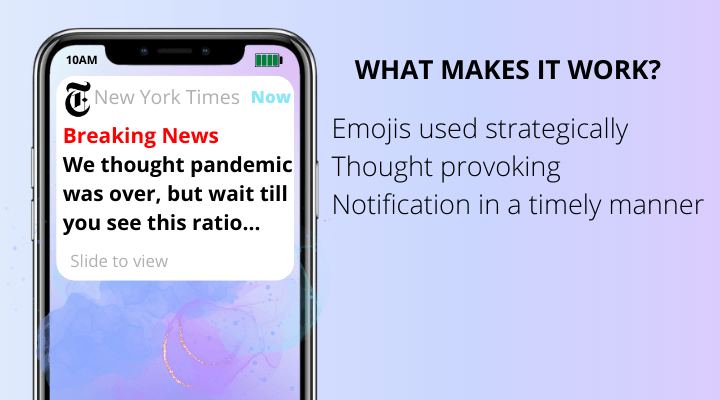
- Timely: This notification was sent simultaneously with the release of a special edition of the New York Times Magazine.
- Personalized: The use of emojis to replace words in this push makes it stand out and the user will spend a few seconds decoding the message in their head.
- Actionable: In the phrase: There’s an ALL COMICS (note the strategic use of capital letters) issue to see! Surely the issue will be as much fun as the push notification.
Types of Push Notifications
Push notifications are often classified into two primary categories based on the use case and message content: transactional and marketing notifications.
Transactional Notifications
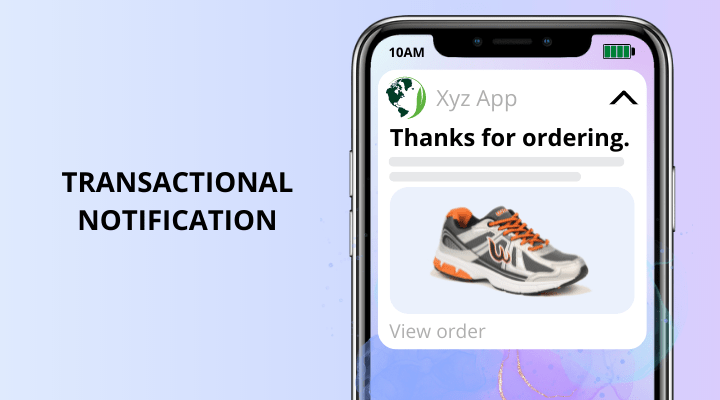
Transactional notifications are messages or push alerts that are issued in response to an app user’s activity. Important status notifications including order confirmations, verifications, payment status updates, and delivery updates might be communicated through them.
Transactional alerts are often prompted by a particular user activity and are a part of a process you’ve initiated with the end-user, such as a recent purchase they made.
Password resets, confirmations, order delivery updates, two-factor authentication, abandoned cart alerts, event registration confirmations, security checks, and welcome messages are all examples of transactional push.
Marketing Notifications
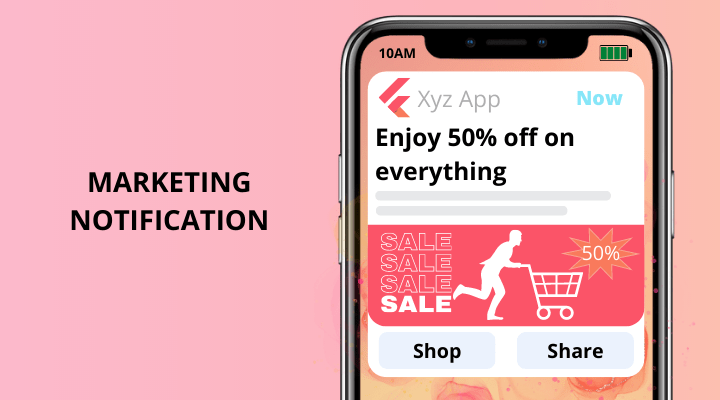
Marketing notifications are not necessary for the app experience, they are secondary. They are sent to engage users with the goal of increasing app retention and boosting revenue.
Marketing messages may include exclusive offers or deals or content to bring users back to your app (user retention). Some examples include flash sales, promotions, and breaking news updates.
These include:
- Rich Push Notifications
- Abandoned Cart Push Notification
- For-your-information (FYI) Notifications
- Triggered Push Notifications
- Reminder Notifications
- Interest-based Geolocation Notifications
- Mobile-friendly Push Notifications
- Time-bound notifications
- Transactional push notifications
- User-based push notifications
Swing2App and push notifications
Now we know that push notifications play a significant role in app marketing through your app, however, you first need to develop an app for that.
The app development costs are huge and then sending regular push notifications may further increase the costs. Moreover, sending a push notification to your users is not easy as sending an SMS text, it requires additional knowledge which most of people lack.
To your rescue comes Swing2app app builder, here you can easily create an app in which you can send unlimited push notifications & that too for free. It also provides many free customizable templates, designs, prototypes, in app surveys, push notifications, SMS, calendar and many fore features,
Once you create an app you can avail of this service on the Swing2app platform and boost the engagement on your app with the remarkable push notifications which would perfectly compliment your free app.
With swing2app ‘Send Push’ Feature, you can also select the recipient and also exclude someone if you want too.
You can send push both instantly and preschedule it too using the ‘reservation feature’. Moreover, Sing2app also provides SMS notification feature too. You can manage and send both your push as well as SMS notifications from the same platform. This definitely makes your job efficient and convenient too.
You can send push notifications via Swing2App using all the prototypes except the WebView prototype.
For WebView you need to integrate OneSignal and send notifications from there.
Read more about Push only and WebView prototype.
Stepwise guide to send Push notifications via Swing2App
Ready to start sending push notifications to your app users? As previously mentioned, you need to set yourself up with a push notification service.
But if you’re using Swing2App to create your app, you can send and manage push messages directly from your Manager dashboard.
1. Go to the Manager.
2. Select Push & Members.
3. Click Send Push.
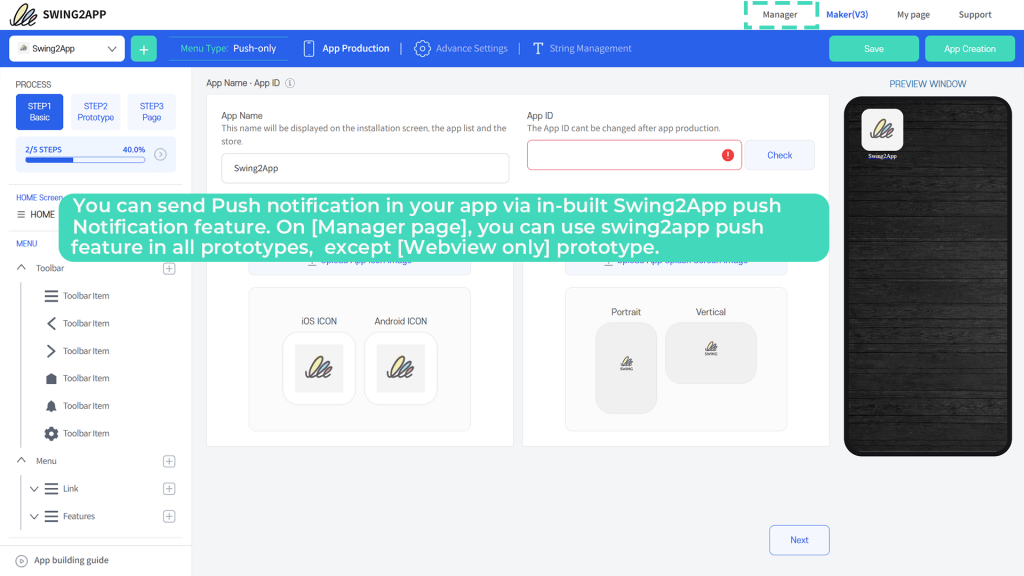
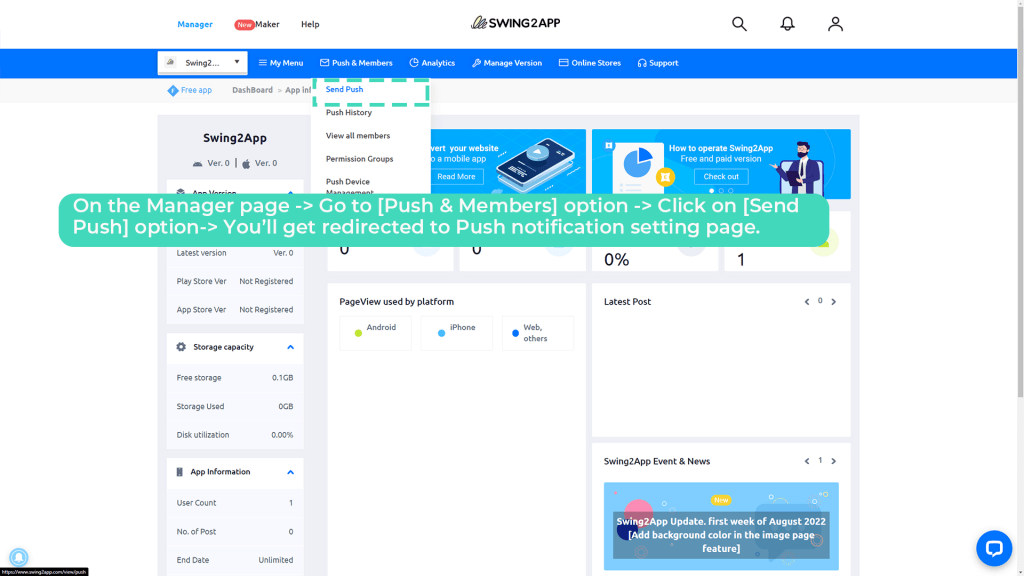
You’ll be directed to Push Management Page, where you can create, edit, and send Push notifications.
1. In Send Push Settings, select members you want to send push.
2. Check Reservation Settings box.
3. Set the date & time you want to send Push.
4. Click on the Send Push button.
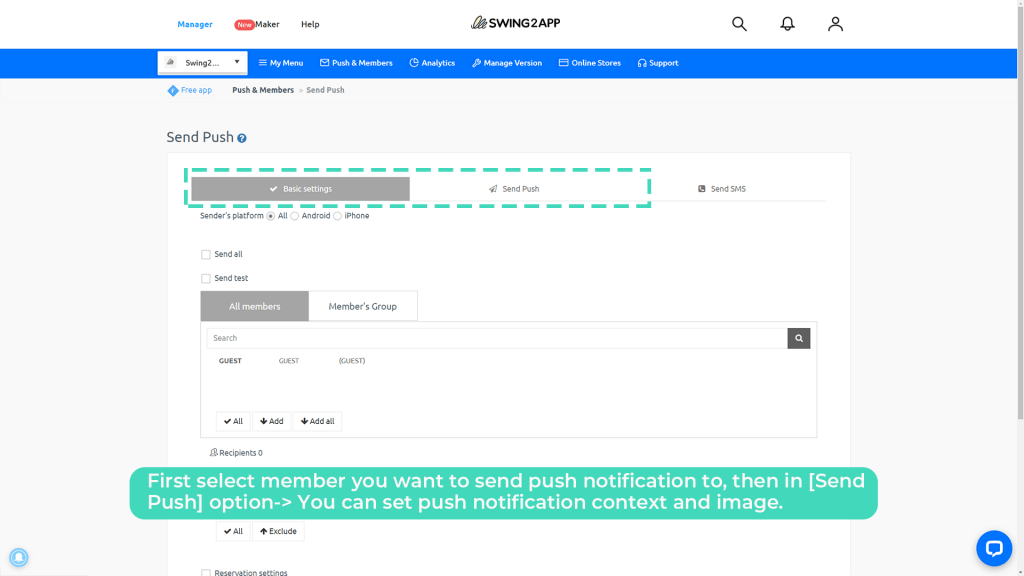
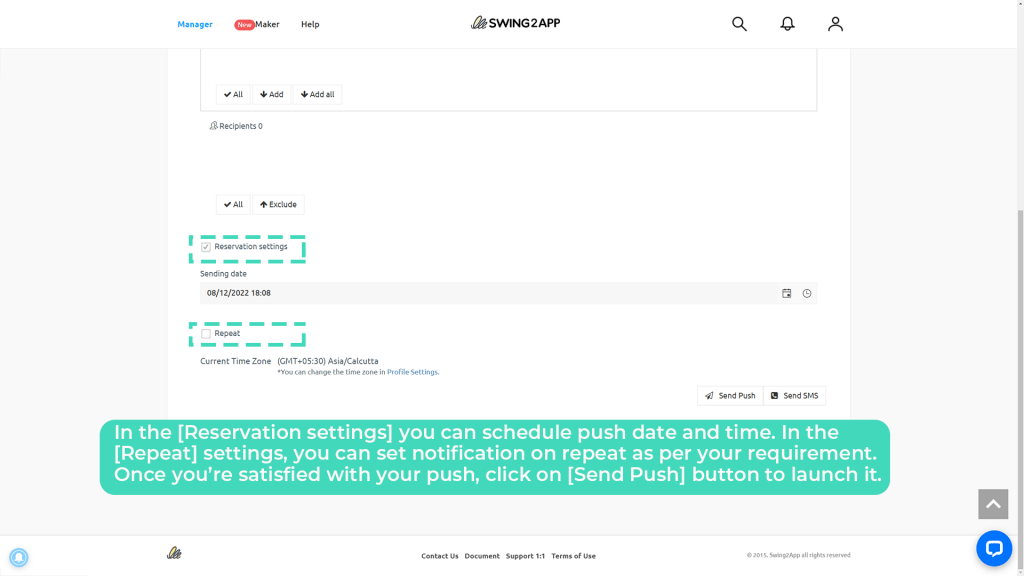
NOTE: If you check Repeat Box, then you’ll be able to set schedule multiple times in a day, week, month, or year.
Swing2App is the easiest way to manage and send push notifications at every step of the user journey.
]]>Customer engagement is witnessing a noticeable decline in its trajectory of popularity. One of the speculated reasons behind this is the changing attitude of customers and the inability of brands to capture it.
Once the underdog is now ruling the principles of customer engagement. In a report, it was mentioned that 87% of marketers report that they see visible improvement in engagement rates after applying personalization.
Now, if only you have been living under a rock you wouldn’t know about the effectiveness and benefits of push notifications in offering a personalized marketing experience to the users of your mobile app.
To say the least, companies can increase the retention rate by a staggering 190% by sending one or more push notifications within the first 90 days of app download.
To understand how you can use push notification for your mobile effectively, we need to know how many types of push notifications exist.
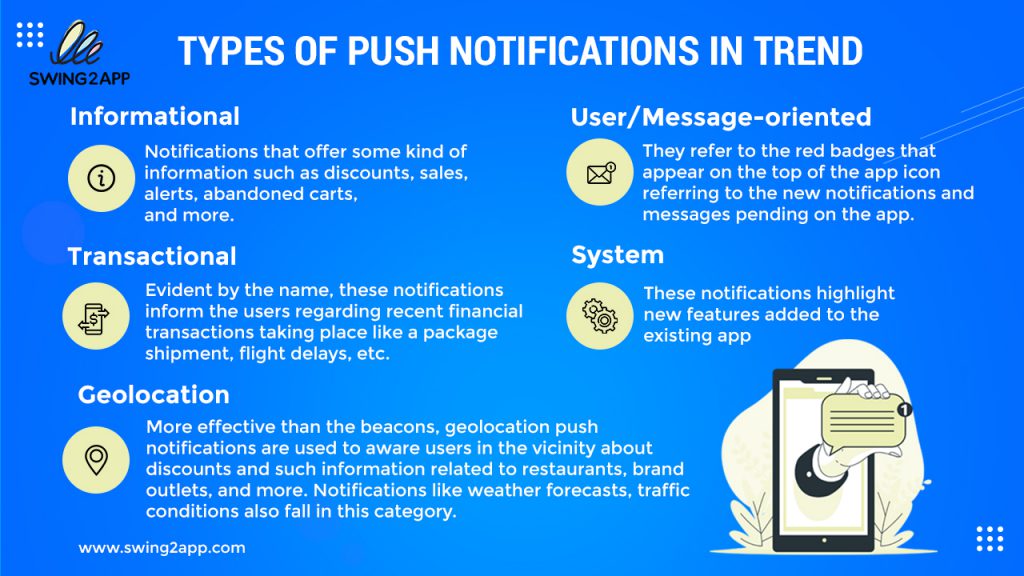
- Informational – Notifications that offer some kind of information such as discounts, sales, alerts, abandoned carts, and more.
- Transactional – Evident by the name, these notifications inform the users regarding recent financial transactions taking place like a package shipment, flight delays, etc.
- User/Message-oriented – They refer to the red badges that appear on the top of the app icon referring to the new notifications and messages pending on the app.
- System – These notifications highlight new features added to the existing app
- Geolocation – More effective than the beacons, geolocation push notifications are used to aware users in the vicinity about discounts and such information related to restaurants, brand outlets, and more. Notifications like weather forecasts, traffic conditions also fall in this category.
Push Notifications vs. Other Marketing Channels
To understand why using push notifications as a marketing strategy for your business is crucial, we need to compare it with the other conventional alternatives to show how insufficient they are.
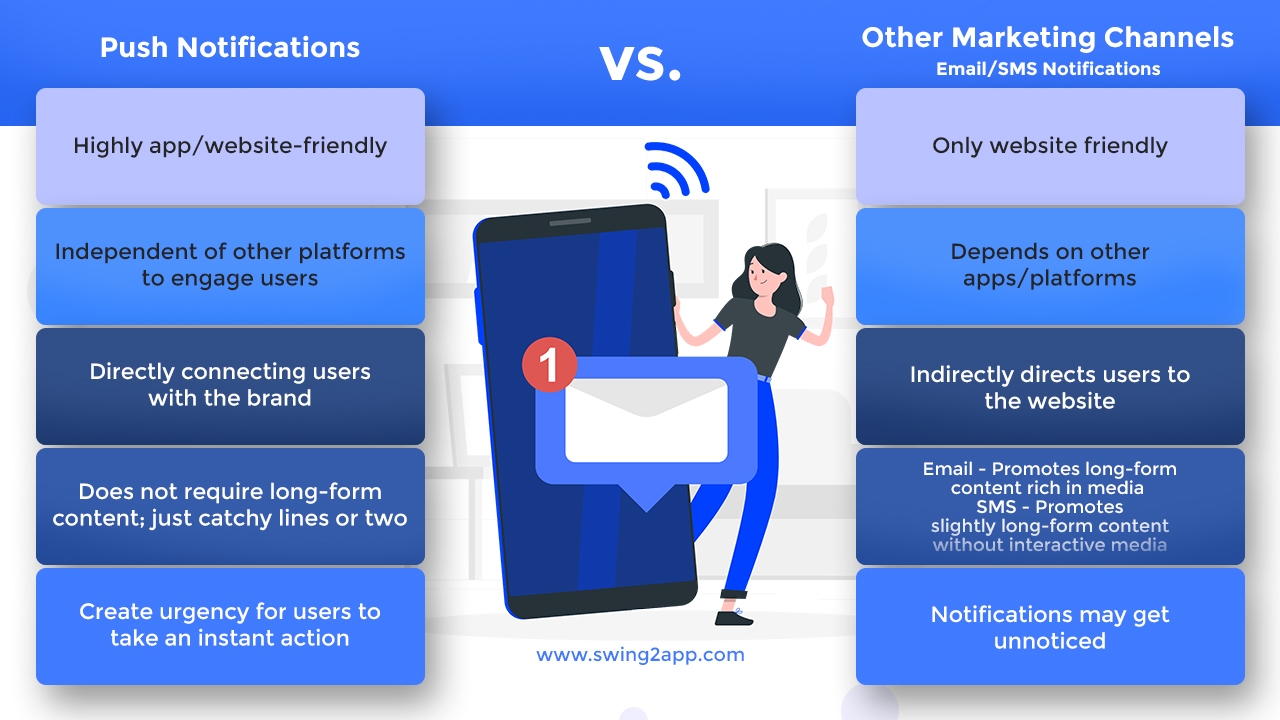
1.Notifications via email marketing
Still, in use by many companies, Email marketing was once an irreplaceable part of outreach strategies and best practices for marketing to promote user engagement. Like everything, it had to come to an end due to the changing world and the people.
As people started to shift more towards smartphones than desktops, mobile apps than websites, email marketing was no longer the ultimate marketing tool it used to be. Thus, the engagement rate declined significantly.
Some of the reasons for this failure are too many emails in the inbox, thus increasing the chances of users checking your email and most of the emails end in the spam folder. Therefore, push notifications came to save the day for businesses as they can be used to promote content on mobile apps.
Unlike emails, push notifications show directly on the screen of the device, thus it is harder to get by unnoticed by the users. Also, by just clicking on it, users can be directed to the app or website directly.
However, one thing that we should probably not forget is that emails allow a brand to be more creative and elaborate than the push notification. Emails are ideal for long-form content containing images, vides, graphics, etc.
On the other hand, push notifications can only contain images, stickers, etc The content word-limit is also constrained so it has to be highly optimized to serve its purpose.
2.SMS notifications
SMS notifications were also used widely for marketing. It is still a strategy that businesses use, but the usage has a limit.
The barrier to creativity and the usage of rich-content has led to its decline in the world where many cost-effective and highly creative marketing tools are available. For instance, the push notification service provider OneSignal push notification service is deemed way better than SMS marketing.
SMS marketing is way more expensive than email marketing which only costs around $200-$1100 as compared to $500-$4000 for the former.
How push notifications are changing the customer engagement game in 2020?
We believe numbers speak better. To convenience you of the remarkable improvements and benefits push notifications offer, we need to discuss some push notification statistics before we get into the details.
- Using the A/B Testing, The Chicago Tribune saw a rise of 56% for its push notification open rate.
- If businesses improve the retention rate by only 1%, they see a 7% improvement in the revenue.
- On the days Gasbuddy sends notifications, they saw a staggering 24% increase in the daily active users count.
Now, that we are done with the numbers, let’s look for more evidence.
Easy opt-in and opt-out
Sometimes, a website might not be able to make a good first-impression in users’ minds. Thus, push notifications can allow them a second chance to do better. They will encourage them to engage with the website to see what the business offers.
Of course, in such cases, the users will not voluntarily or by themselves visit the website with which they share unpleasant experiences, but push notifications can push and motivate them to give another chance.
Unlike SMS messages, when users open a website, they are asked for permission if they want to be a part of the push notification campaign. Even in the case of mobile apps, users can go to the settings and stop the notifications from a particular app.
Interaction with the user is only a click away
Okay, let’s compare. When it comes to SMS marketing, users had to first open the message and then click on the link provided to land on the website. Similarly, with email marketing, a user is supposed to first open the email inbox, then the email, and then would reach the targeted website page.
But with push notifications, things are not unnecessarily complicated. Users are only required to click on the push notification in the notification bar and they will be redirected to the website or the app. This simple yet effective strategy enables businesses to push more users down the conversion funnel.
Retarget and retain
It is a known fact that acquiring new users for a business is even more expensive than retaining existing ones. If you want new customers, you would have to spend hundreds of dollars on advertisements to just get the attention.
Whereas, with an effective push notification strategy, you can make sure that your existing customer base is loyal and active. There are high chances of customers retaining on your website/app if they receive appropriate push notifications within the appropriate period.
With a viable notification, users will be more inclined to open them and re-visit your app/website to drive more business. Thus, a business has to make sure to devise personalized push notifications to ensure a high retention rate. Once this is taken care of, the engagement rate will improve in itself.
Creates urgency to increase CTR
Push notifications are a great way to create urgency among the users to interact with your website/app. For example, a notification informing of a limited-time offer or discount deal will make them more eager to click on the notification and land on your platform as soon as they read it.
You do not need long-form content but just a catchy heading with an interacting line or two with engaging emojis and other things to make it more interesting.
Easy user behaviour tracking
An effective analysis of user behaviour with your brand will allow you to offer services that users demand. This also helps in improving the existing services. To obtain this implicit feedback, a brand must know how to procure this useful information from a pile of numbers.
With push notifications, businesses can analyze the delivery receipts, open rates, open time, clicks on the notifications, etc to know how users are interacting with their brand. Businesses are more likely to easily evaluate which types of notifications users prefer
Last but not least, activate your inactive users
Your job does not end once the users download your app. Many times, users download the app but almost never even open it or if they do, the engagement is still lacking.
Therefore, a well-curated push notification strategy will take care of this issue. It will encourage them to interact and remind them of your services, unlike a website on which they once visited but never agreed to push notifications so there is no way to win them back.
Push Notifications: Do it right or don’t do it at all
After reading these amazing things about push notifications, we believe we have established a deep understanding and trust. Now, you must be thinking – ‘How to enable push notification for a mobile app?’.
{Know-How: Learn how to create your own app for free and without code}
Once you create an app you can avail of this service on the platform and boost the engagement on your app with the remarkable push notifications which would perfectly compliment your free app.
Isn’t this an amazing deal for businesses and especially startups with the dynamic and catalytic idea but limited capital?
]]>